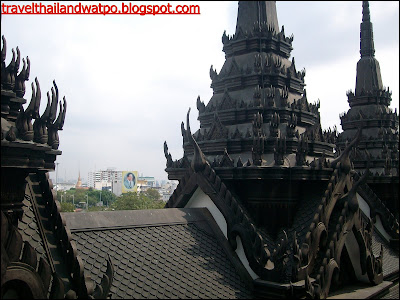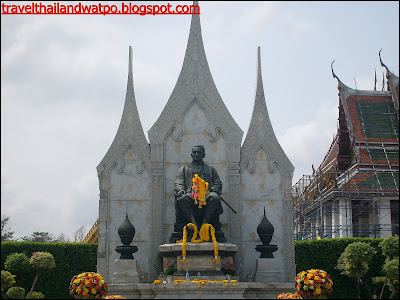LOHA PRASAT
A Thai Buddhist Architectural Masterpiece, the only one that lasts to the World
In 1846, H.M. King Nangklao, the third monarch of the Chakri dynasty, decreed that Wat Ratchanaddaram Worawiharn be built in honour of his favorite grand daughter, Princess Samanas Wathanawadee. The King himself designed construction plans of the temple and by Royal command, the Loha Prasat was erected as the priciple building on the temple grounds.
It is assumed that it was King Nangklao's desire that the Loha Prasat serve as the living quarters for monks who could also practise the Dhamma teaching. According to historical records, the term, Loha Prasat, refers to a multi-storeyed building with a metal roof. In the past, only two building of this kind existed in the world-one in the city of Sawatthi in India and the other in Anurathpura in Sri Lanka. Both had been ravaged by time and ceased to exist several centuries ago. The Loha Prasat in Thailand was the third structure of its kind to be built in the world and is the only one that remains standing in its complete form today.
The Loha Prasat in Wat Ratchanaddaram is a Buddhist architectural structure that is "superior" to other exemplary forms of Thai architecture. This large construction is of seven storeys and is equipped with a spiral stair in the centre. The roof of the Prasat is decorated with thirty-seven spires in the Mondop style. The number 37 symbolically represents the Thirty-seven article in the Bodhiphukkhlyadham- the seven sections of the Dhamma discourse that must be observed in order to attain enlightenment.
The Loha Prasat remained unfinished in the reign of King Nangklao. After that attempts were made to complete it but due to problems and obstacles, the building was not completed until the present reign of H.M. King Bhumibol Adulyadej. The government and the private sector as well as people from all walks of life - monks, businessmen and devout Buddhises, collaborated to raise funds to continue and complete the construction. The work indicates a combination of knowledge of Thai architecture, Thai traditional arts with appropriate technologies. The Department of Public works at the Ministry of interior was responsible for the first phase of the construction (1963 - 1977) and the Fine Arts department at the Ministry of culture took the task of being the major organization that supervised the work to its completion in 2007.
In the topmost part of the Loha Prasat a relic of the Lord Buddha is housed. presented to the temple by King Bhumibol Adulyadej who graciously presided over its enshrinement in the Busabok pavilion at the top of the Loha Prasat on February 27th, 1995. This ceremony marked the commencement of the Golden Jubilee of His Majesty the King in 1996.
History of the Construction of the Loha Prasat in Wat Ratchanaddaram
1846 : At King Nangklao's behest, Wat Ratchanaddaram was built with the Loha Prasat as the principle building of the temple.
1851 : King Nangklao passed away, resulting in a halt in the building of the Loha Prasat. The only part to have been completed was the structure made of brick alternating with laterite.
1901 - 1909 : The Loha Prasat was restored by Phraya Petchpani, the temple's manager and Phra Prasitsuttakhun (Daeng Khemtutho), the abbot.
1963 - 1972 : The Department of Public Works renovated the Loha Prasat and strengthened it with re-inforced concrete, provided a drainage system for rain water and improved the spiral stairways, the windows and the doors as well as decorating the building's surface.
February 27th, 1995; His Majesty the King enshrined the Lord Buddha's relic in the Busabok pavilion in the Loha Prasat, Wat Ratchanaddaram.
1998 : The Fine Arts Department surveyed the area and explored historical evidence before further renovation.
1999 : The Fine Arts Department launched the first phase of the restoration of the Loha Prasat by repairing the middle Mondop spire and improving the surrounding landscape.
2000 : The Fine Arts Department undertook the second phase of renovation by repairing twelve Mondop spires in the middle of the building.
2002 : The Fine Arts Department began the third phase of renovation by repairing twenty - four Mondop spires in the lower part of the building.
2007 : The renovation of the Loha Prasat was completed.








































No comments:
Post a Comment